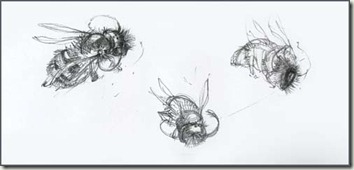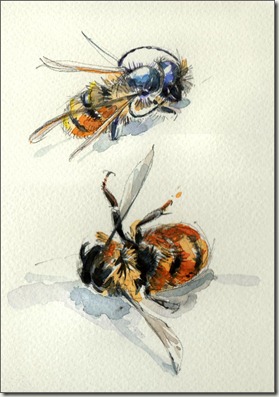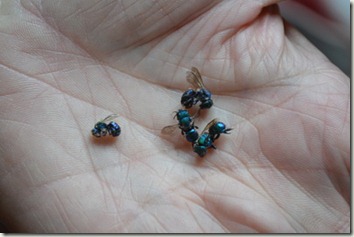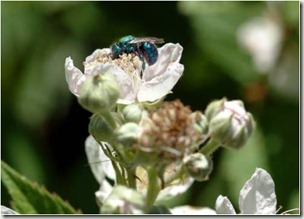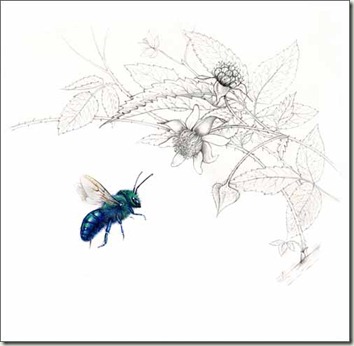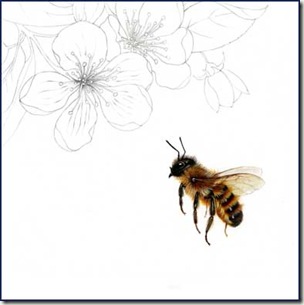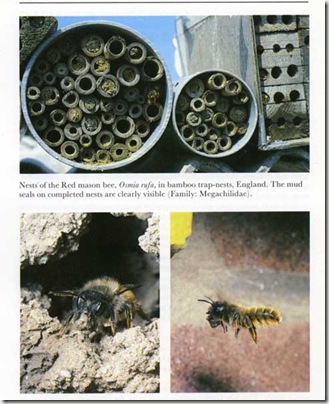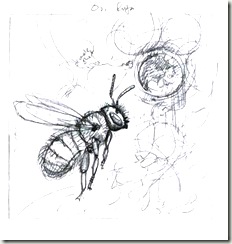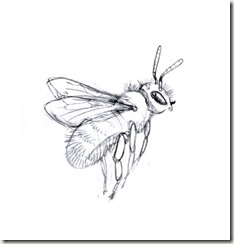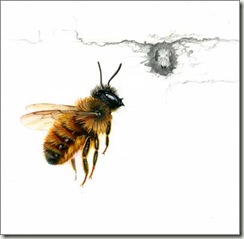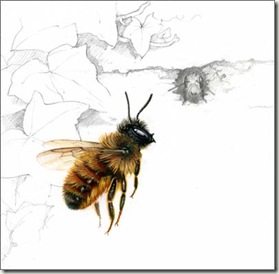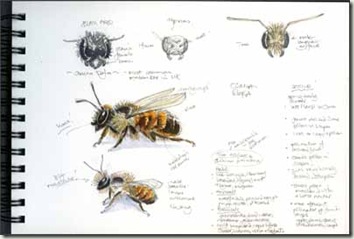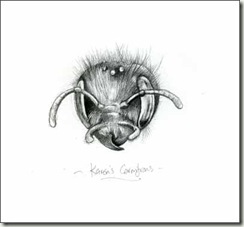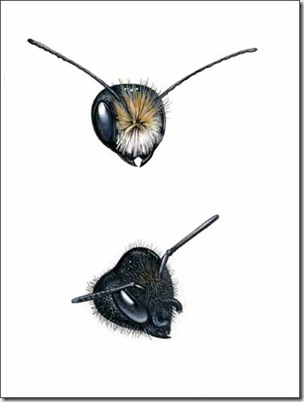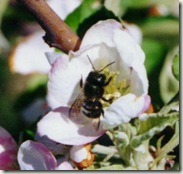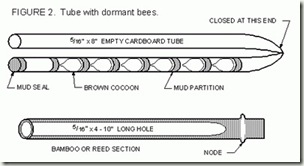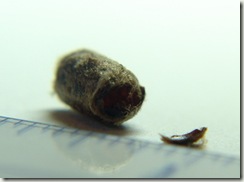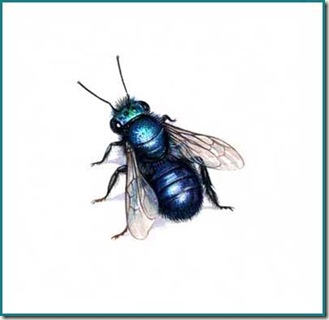The headline that first caught my eye when I started reading about these bees, says it all.. “This Bee Is Gentle” … A fact that is reiterated again and again, here is a quote from “The New Mexico Native Bee Pollinator Project” calling on gardeners in NM to help make “bee corridors”;
“Gardens for the more flamboyant hummingbirds and butterflies have become popular; now the bees need our support. There’s a fear factor with bees however, even among nature lovers.
Honey bees sting because they have a treasure trove to defend, and a queen who lays all of the eggs. Not so with native species: the vast majority of them are solitary bees who ARE VERY DOCILE and do not sting unless they are handled roughly.
When we become educated about our bees, a new understanding develops that they can be both safe and a delight to have around.”
This comes from the USA site Pollinator Paradise which has as much information about Blue Orchard Mason bees and other helpful native bees as you could ever wish for. It is run by Dr Karen Strickler who I have to thank for information, samples and pointing me in the right direction for my research on these bees.
Orchard bees have many champions and I have been amazed by how many suppliers are selling mason bee items, you can buy mason bee homes, which come in many different varieties from high rise blocks to bundles of straws; you can buy mason bee videos, mason bee online courses, and of course the bees themselves which come as little cocoons with full owners manuals.
Blue orchard bees overwinter as dormant adults so you can watch them emerge in the spring ready to start work, For a comprehensive listing of suppliers of everything, go to Pollinator Paradise here. You will be there for hours..!
So why all the fuss? Well this little bee is an ace pollinator of fruit crops and again, in face of the honey bee decline, the native bees are coming into their own.
If you have a small domestic orchard.. apples, cherries and other tree fruit just 50 blue orchard bees will help secure you a good crop.
(These bees are endearingly referred to as “BOBs” by the US Dept of Agriculture and there is a good article about them plus their possible predators here.)

BOB, on apple blossom from Karen Strickland at Pollinator Paradise
Minor mining
Although these are “solitary” bees, with each female making her own independent nest, they are gregarious and like to nest close to each other. They are opportunist nesters and will use old insect holes in wood, nail holes, and spaces in crumbling mortar.
They are not destructive as often thought as they do not burrow into mortar, but just make do!
Their name mason bee comes more from the fact that they seal their nests with mud.. so they make rather than destroy. They also like old hollow canes and can have as many twenty nest cells in one cane. J
ean-Henri Fabre, who I mentioned in the last post had hoped to find some Osmia nesting in the upright hollow reeds used by gardeners and farmers for fencing and supports…..from “Bramble Bees and Others” 1915:
I have often explored them in the hope of finding Osmia-nests. My search has very seldom succeeded. The failure is easily explained. The partitions and the closing-plug are made, as we have seen, of a sort of mud which water instantly reduces to pap.
With the upright position of the reeds, the stopper of the opening would receive the rain and would become diluted; the ceilings of the storeys would fall in and the family would perish by drowning.
Therefore the Osmia, who knew of these drawbacks before I did, refuses the reeds when they are placed perpendicularly.
Smart these bees..!

Drawing by Mike Kridle from Pollinator Paradise here
The Orderly Queuing of Bees.. with just a bit of nipping and shoving.
The tubular nests are fascinating and it seems that the size of the bee may depend somewhat on the size of the tube. The bee painstakingly makes each cell, bringing pollen and honey to each, lays her egg, seals the cell with mud, then moves on.
The lava will eat the provisions, spin a silk cocoon and stay in this safe house until the spring. In a way that is still not understood the lava knows which way to face before it spins the cocoon, facing backwards would be a disaster as there is only one way out.
I detected a problem here… if the first bee at the back of the nest develops first how does it get out when its younger siblings are still in their cocoons?
“Bees of the World” by Christopher O ‘Toole and Anthony Raw explains:
“Because of the linear arrangement of the cells ..the youngest bee emerges first, followed by the progressively older bees. However as may be expected the oldest bees in the deepest cells often awake from their winter dormancy first.
An older bee is thus likely to meet with a still dormant bee in the next cell between it and the nest entrance.The problem is solved as follows: when the bee has bitten through the partition into the rear of the next cell it bites its way through the cocoon of the bee in front.
If the occupant is inactive the bee nips the rear of its abdomen. This awakens the second bee which begins to vibrate its wings.. Nipping is repeated if necessary until the bee nearest the entrance starts to bite its way through the nest enclosure.”
This is an empty cocoon which Karen Strickler kindly sent me.
It is a beautiful translucent thing, light but very strong and fibrous.. just 1/2inch long
.
It occurs to me that Orchard bee cocoons complete with housing would make a wonderful Xmas gift for the keen gardener and nature loving child.. and me… (taps Chris on shoulder!)
If you in the UK there is lots of advice in the Nigel Jones’s excellent “Solitary Bees” pages here. (interestingly Nigel appears to be a cat)
Bee Friendly Gardens
Dr Strickler has some good advice for creating a bee friendly garden here.
Attracting these little bees is more about getting the right flowers at the right time, as they are most active between April and July.
Bob sketches
This is a pretty bee, and another challenge as she is a shiny blue/black but also quite a hairy little creature. This is the female. The smaller male has a rather fetching moustache and longer antennae. I am saving him for later.

___________________________________________________________
Bee number 14: Osmia lignaria, the very dainty Blue Orchard Bee

Watercolour on Arches 300 HP, image 3.5”

